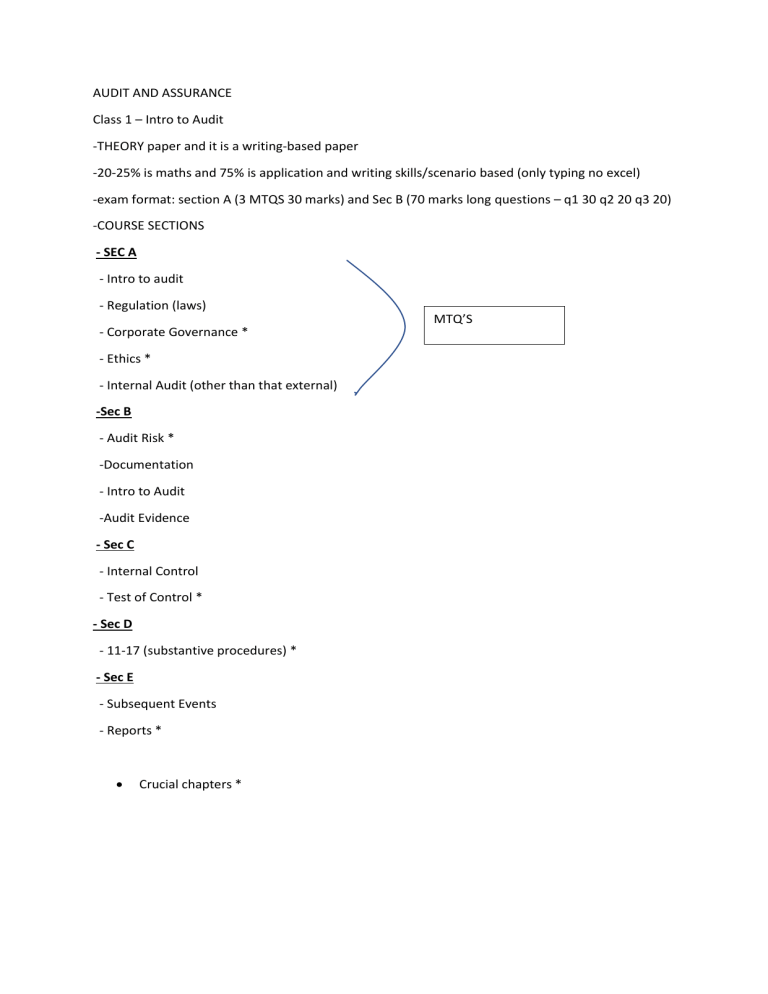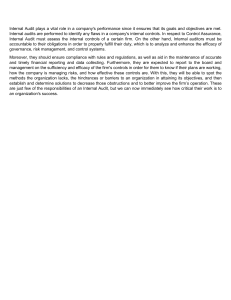
AUDIT AND ASSURANCE Class 1 – Intro to Audit -THEORY paper and it is a writing-based paper -20-25% is maths and 75% is application and writing skills/scenario based (only typing no excel) -exam format: section A (3 MTQS 30 marks) and Sec B (70 marks long questions – q1 30 q2 20 q3 20) -COURSE SECTIONS - SEC A - Intro to audit - Regulation (laws) - Corporate Governance * - Ethics * - Internal Audit (other than that external) -Sec B - Audit Risk * -Documentation - Intro to Audit -Audit Evidence - Sec C - Internal Control - Test of Control * - Sec D - 11-17 (substantive procedures) * - Sec E - Subsequent Events - Reports * Crucial chapters * MTQ’S MR A SECTION A MR B Investor Chapter 1: Intro to Audit What is Audit? An audit is an independent examination of f/s which enable the auditor to express an opinion on: - - Whether f/s are prepared (in all material aspects) in accordance with an applicable framework (IFRS/IAS) Material – can affect f/s and decisions Whether f/s gives a true and fair view True = can be verified by supporting documents Fair = made with positive intentions Mr B needs an independent audit for honest, professional opinion Company real owners are shareholders, appoint directors to run business (agency/steward relationship) Types of Audit - Statutory Audit (mandatory) o Has no adv/dis bc it is a legal requirement Non-Statutory (voluntary) o Advantages It is a means of settling accounts b/w partners (true and fair) Helps to get loan from bank Acceptable to tax authorities Enhances public image (donations increase) o Disadvantages Time Consuming Costly !!!! Auditor never gives absolute assurance/guarantee that everything is correct Only gives a reasonable assurance (80-85%). The difference between the public perception and reality is called expectations gap. Why audit then? Why does auditor not give absolute assurance? This because there are inherent limitations of audit: o o o o Auditors are human so there is always a possibility of human error Not all items in f/s are tested i.e. audit is on sample basis rather than population. Sometimes management is involved in fraud and thus it is difficult to identify management fraud. F/S are based on estimates and estimates can be incorrect Audit firms offer 5 things: - Audit o Of f/s o Done by auditors f/s made quarterly o o o - Review o o o o o Fees Detailed examination (worm eye view) Reasonable Assurance (80-85%) Positive wording “F/S give true and fair view” 6 month – if shareholders are doubtful then review because less costly and timely Of f/s Done by auditors 12 month – Fees compulsory Less detailed Examination audit Limited assurance (40-45%) Negative wording “Nothing has come to our attention that causes us to believe that f/s do not give a T & F view.” What is a Review? Companies usually prepare f/s after every 3 months and shareholders may doubt the f/s. Thus, to overcome it, the auditor is called to review the f/s instead of an audit. Agreed Upon Procedures In an agreed upon procedure, an audit firm and client agree on a task and audit firm takes fee and performs that task. Since it is not an audit or review no assurance is given. Compilation Engagement In compilation engagement company gives data and records to audit firm and asks them to compile f/s for them. Audit firm takes fee and compiles f/s for them. Since it is not an audit or a review so no assurance is given. Due Diligence If a company plans to take over a company, they sometimes have audit firms to do due diligence i.e. check financial HEALTH of that company. This helps the company to decide if they should takeover or not. Assurance Engagement Audit is an example of assurance engagement Any activity can be called assurance engagement if it has these 5 elements: (CREST) 1. Criteria: assurance must be done in a suitable criterion. Audit has ISA. 2. Report: The assurance must be followed by a written report like in case of audit written report is submitted in the end. 3. Evidence: The assurance must be based on some evidence like in case of audit sufficient appropriate evidence is gathered. 4. Subject Matters: assurance must be on some subjects like in case of audit it is f/s. 5. Triparty Relation: There must be 3 parties involved: a. Practitioner – one who practices e.g auditor b. Intended User (for whom report is being made e.g shareholder) c. Responsible Party (who is being doubted e.g directors) Responsibilities of Directors and Auditors Directors Responsible for preparation of F/S Responsible for making assumptions Responsible to prevent and detect fraud and error Responsible to assess whether company is a going concern Auditors Responsible for audit of F/S Responsible to assess reasonableness of those assumption Responsible to ensure F/S are free from any fraud and error Responsible to ensure that assessment of going concern is correct



